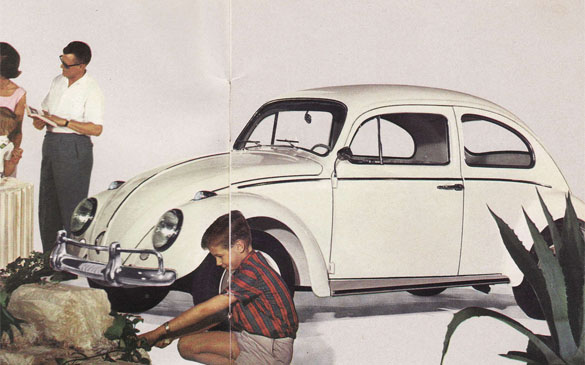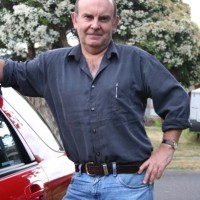
What does the Victorian Railways blue Harris train have in common with the VW Beetle? They were both built in Clayton, near Melbourne, by the same company, near the site where Holden Special Vehicles is based today. Australian assembly of the VW Beetle from June 1954 occurred in parallel with the manufacture of Melbourne’s first new commuter train design since 1910 ready for the Melbourne Olympics in 1956. Even more bizarre was the invitation for the Australian Government to requisition the complete Volkswagen facility in Germany after 1945 as war reparations.
Because the Australian military was exposed to the effectiveness of the Kubelwagen in the North African desert campaigns, building VW military vehicles for Australia’s desert conditions while offering the Beetle to civilians seemed to make sense and was a serious option. The first VW Beetles in Australia were two 1945 models brought in by the military for evaluation under this scenario.
Sir Laurence Hartnett, following his work in establishing the first Holden, inspected the Wolfsburg factory to assess its suitability as a second all-Australian car in 1947. He correctly anticipated that both the car and its manufacturing processes were too sophisticated for the relatively small Australian market at that time.

Although the Australian Government was still interested, the German company had re-established itself with such speed that it had become a major player in achieving self-sufficiency for its home region in Germany. Because this reduced the financial burden on the British occupying forces, uprooting the whole complex for relocation to Australia was no longer a default option. After VW started exporting in 1949, the British wasted no time in handing Volkswagen control of its own destiny and removing the threat of relocation.
The first official VW exports to Australia therefore did not occur until late in 1953. Despite the lukewarm reception initially, it was like removing the cork from the genie. By June 1954, full local assembly had commenced by Martin and King in Clayton. As railway rolling stock builders gearing up for Melbourne’s first all-steel passenger train, Martin and King were the perfect fit for relatively complex Volkswagen assembly. Because of the nature of their railway work, there was also a major rail link to the factory doors!
These first cars were the updated “Export” specification with oval rear windows , upgraded bumpers, enamel paint, 15 inch wheels and the speedo in front of the driver. The Beetle as Australians knew it was defined from this first batch. Within months of the first 1953 spec cars, the engine was boosted from 1131cc to 1192cc or 1200 spec for 1954 which continued unchanged into 1960.
Volkswagen recruited the local Land Rover distributor as the target market was similar. Regional rural tractor dealerships were later added including Massey Ferguson which ruled the local market as it was also backed by a big local factory. By 1957, VW had won a deal with the Australian government for duty concessions on the promise of achieving 95 per cent local content in Australian Volkswagens. The deal allowed specialist imports such as the Karmann-Ghia and Microbus to supplement the Australian-built models at realistic prices. After the Clayton premises of Martin and King were acquired, the Australian Volkswagen facility at Clayton soon became the biggest VW plant outside Wolfsburg.

Australia’s Oldest Beetle Competition 1961
By 1961, local content along with competition achievements had increased to such a high level that Australians regarded Volkswagen with almost the same affection as the local Holden. The local industry generated considerable pride after it demonstrated that it could produce such a different and sophisticated vehicle to at least the same standards as the German original, if not better in several areas, as dictated by local conditions.
It was also the last year that the VW Beetle would have the small car market on its own terms as a new local Mini, Ford Cortina and Vauxhall Viva were about to transform local choice and value for money. A pre-emptive strike highlighting the Beetle’s longevity and local credibility was delivered with surgical precision.
Volkswagen Australasia surfed the wave of local loyalty and pride by generating a huge local competition supported by massive full page broadsheet advertisements inviting Australians to identify the country’s oldest Beetle so its owner could be given a brand new one in exchange. It almost backfired as it was expected to deliver a close run competition of oval window Beetles from the 1953-54 period. The two army evaluation vehicles had long ago disappeared from sight.

Imagine the shock when the search uncovered a totally original black split-window Beetle from 1946 that hardly anyone knew was in the country. It had been brought to Australia by a German couple who had purchased it from its original owner, a British officer.
It ended up in the Wimmera farming district north-east of Melbourne where its rarity and local usage would hardly have raised an eyebrow as it clocked-up over 160,000 reliable kilometres. VWA was true to its word. A brand new VW Beetle 1200 made of Australian steel was exchanged for the older car, with the State Premier officiating at the ceremony. It marked the local assembly of 100,000 Beetles.
VWA followed up with an equally high profile campaign highlighting the 1946 and 1961 cars. They generated enormous interest at local motor shows and for the ex-factory price of a new Beetle, the coverage was ballistic. The local 1961 model with its small overrider bumpers appeared to be little more than a prosperous evolution of the 1946 car, adding extra glitter only as buyers could afford it. This avoidance of change for change’s sake resonated deeply in an Australian psyche and economy where infrastructure was still minimal and spending power was dependent on fickle seasons and overseas markets.

The 1962 ½ Beetle
Prior Beetle upgrades to this Australian model loosely followed German updates including larger rear window, indicators, dash and trim. The 1962 ½ Deluxe was an important catch-up model before the next level of Australian content, around 85 per cent, would kick in from 1964. It was a hugely successful update as it added glitter and presence to the Beetle at exactly the point when the first of the baby boomers were about to hit the roads.
Apart from barely discernible changes to trim, rear number plate light, front indicators and bonnet trim between 1962 and 1967, this model determined the look of every local manufactured Beetle until the factory reverted to imports and local assembly in 1968. It was at once the source of local success and its ultimate failure as its local body isolated the Australian Beetle from critical German facelifts. The Beetle ran headlong into Japanese models that were far better-equipped along with road improvements that no longer made the Beetle’s strong points so critical.
The 1962 ½ was the first to boast the Made in Australia sticker in the back window. The bumper nudge extensions were supported by full-depth overriders, the tail lights had three sections instead of two, the colours and trim were brighter, there was a fuel gauge introduced only months earlier, spring-loaded bonnet support, seat belt mounting points, adjustable heater vents as well as dust-proofed steering parts and upgraded steering box. It was the last with the Wolfsburg crest up front as the local transformation was all but complete.

An oddball Standard model was then created locally by deleting the fuel gauge and glovebox lid as the chrome inside and out was either deleted or replaced with silver frost. The cabin was little more than a painted steel shell with the plainest seats possible. The stupidity was that it cost as much to build as a Deluxe as most of the cheaper parts dictated extra labour and inventory. It created a two-tier range that could only make the Deluxe look more attractive. As the model evolved into the Custom, VWA found it was cheaper to leave most of the appearance items intact.
Local advances were enough to prompt this writer’s uncle, who was a research scientist charged with making Australian wool more suitable for the local car industry amongst other applications, to trade in a 1940s Chevrolet and a much-loved BSA motor cycle for a brand new Yukon yellow 1962 ½ Beetle Deluxe. Typical of many urban owners in this age group, he used it for the daily commute then as a getaway vehicle for a wife and two kids beyond city limits.This included the challenging annual fully-loaded trips to the mountains to enjoy Australia’s fledgling ski industry. Nothing broke and little wore out over a tough life.
The Beetle’s ability to cope with Australian temperature extremes saw an Australian-built example of the same series sent to Australia’s Mawson base in Antarctica where it excelled as a runabout for the scientists posted there. Again, VWA publicity exploited its ability to survive some of the most inhospitable regions on earth of which Australia had more than its fair share!

A Guide to the Local VW Beetle Deluxe
1954: Oval window, single exhaust, push button starter left of fascia. Early cars had 1131cc engine/22kW. Annual Sales: 1747
1955: All locally assembled cars had 1954 update with 1192cc engine/27kW, twin exhaust outlets, bigger boot, extra rear leg room. Annual Sales: 5805
1956 (Oct): Trim, paint, heater system and fuel tank revised. Annual Sales: 9230
1957 (Aug): Larger rear window, new rear intake grille, new dash, bigger glove box, flat organ-type accelerator pedal. Annual Sales: 10384
1958: Unchanged. Annual Sales: 13759
1959 (Jun): Vinyl headlining, front anti-roll bar, softer rear torsion bars, push button exterior door handles, dished steering wheel, half-horn ring. Annual Sales: 17747
1960 (Nov): New 1192cc engine/30kW with different crankshaft and crankcase, automatic choke, 1st gear synchro, windscreen washers, indicators on front guards.
Annual Sales: 24,652
1961 (Nov): Fuel gauge, nudge bars linking overriders. Annual Sales: 15254
1962 (May): 1962 ½ series. Adjustable heater vents, door stays, fold down rear seat, sealed tie rod ends, three section tail lights. Annual Sales: 21362
1963: Unchanged except more local parts. Annual Sales: 19160
1964 (May): Almost full local manufacture, wider front indicators, welded leather grained trim replaces pleated type, wider rear number plate light. Annual Sales: 22150
1965 (Mar): Contoured seats with rounded seat back tops. Annual Sales: 18067
1966 (Mar): Local small window body combined with new 1285cc engine/37kW, softer gearbox mounts, 1300 badge on engine lid.
1966 (Nov): Gear lever cranked rearwards. Annual Sales: 9735
1967 (Feb): Australian DeLuxe version of old body 1300 with whitewall tyres, brighter colours, perforated seat trim, needle punch headlining, single tone door lining. Annual Sales: 10580
1968: Local manufacture ends. Final 1300 examples overlap imported and locally assembled 1500 Beetle stocks that match current German specification. Annual Sales: 6433



